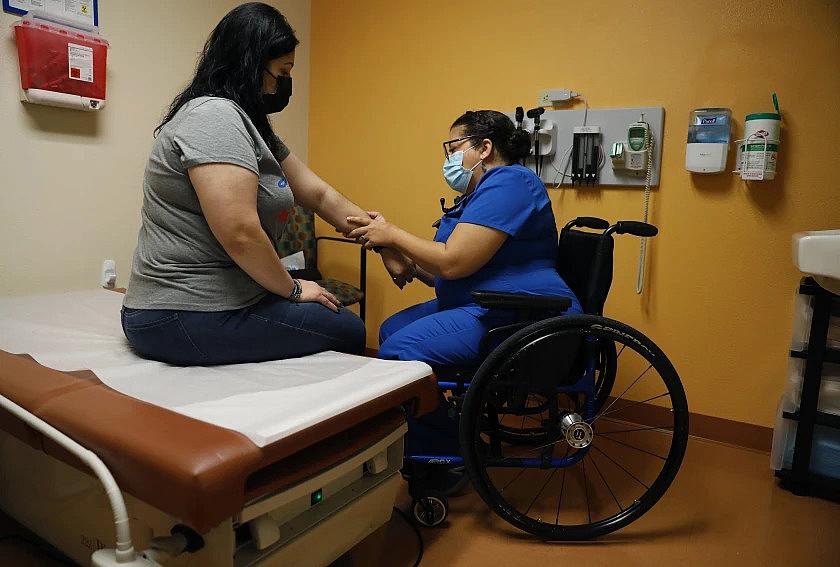A journalist turns to a chorus of voices — including her own — to tell stories of being disabled and pregnant

Photo by Christina House/Los Angeles Times
“Where do stories come from?”
This was one of the most common questions I heard when I used to teach journalism. It’s also one of my least favorite to answer, because even my most important stories seem to come from the most ephemeral sources: a stranger’s jacket in a coffee shop; a phone call with my mom; some snacks I bought at a crime scene that one time. And in the case of this project, the parenthetical at the end of an email exchange.
My project explored how modern obstetrics has turned its back on the large and growing number of disabled women who get pregnant, failing them at virtually every step on their journeys to motherhood, and harming them in ways that cannot be explained by medical complexity or anatomical difference.
Like my subjects, I am disabled. I had also just gotten pregnant. One could scarcely construct a more obvious origin story — except that I had no idea I was expecting when this piece was conceived. In fact, when fellowship recruiter Martha Shirk emailed me to ask if I would pitch a project for the 2021 California Health Journalism Fellowship, I had just started reporting on the sharp decline in births among women my age.
Instead, the germ of this story was a throwaway line about extra funding “for a project focused on children 5 and under (or pregnant women) in L.A. County.”
I’d been covering child care since the start of a pandemic, so a project that focused on young children seemed like a natural fit. But I ran a quick clip search for disabled pregnant women just in case.
To say I came up empty would almost be an understatement. No matter what terms I used for disabled parents, the results were overwhelmingly about disabled children. If I hadn’t already been pregnant and given birth five years earlier, I would have assumed that mothers like me did not exist. When I eventually did find research and data about disabled pregnant women, almost all of it was younger than my son.
Yet this new research clearly showed that disabled women were getting pregnant and giving birth in significant numbers, and that their ongoing absence from maternity statistics and medical training was itself causing harm. To me, this was a tantalizing premise. The natural dramatic arc of a pregnancy would give it form and flow.
Unfortunately, the same thing that made the story compelling made it incredibly difficult to report.
For one thing, disability itself is defined differently by different bureaucracies. This is in contrast to features like race or poverty status, which are roughly uniform from state to state and system to system. A parent who is considered disabled by the Department of Education may not be disabled to the DMV or the Social Security Administration or the U.S. Census, nor will their disability necessarily be covered in existing research.
For another, these subjects were significantly harder to find and talk to than the patients I’d interviewed about California’s confusing vaccine rollout a few weeks before. There are almost no services or support groups for disabled parents the way there are for parents of disabled children, and they are also relatively less likely than other disabled people to be connected to independent living centers. Their online social networks are often diagnosis-specific and closed, and enduring stigma makes many of those who can be found leery of sharing their struggles in public.
Trying to find parents through the medical system proved only slightly easier, as relatively few obstetricians will treat disabled patients, and fewer still treat them regularly. I heard back from just two of the dozen or more L.A. County medical systems I contacted.
Finally, the government doesn’t collect or disaggregate maternity statistics by disability status the way it does by race, geography or income; the most comprehensive data we have is a statistical triangulation of birth records and disability-associated diagnostic codes, which makes it prohibitively complex to collect and analyze independently.
When I first pitched the project, I imagined I would easily find a subject in her second or third trimester or pregnancy, and that I would weave a thread of new data into the narrative of her birth story. I wanted the love and resilience of a single disabled mother to shine through the statistical suffering.
But I quickly realized that frame was too constricting. For one thing, it minimized the breadth of the harm, and the commonality across different disabled identities. For another, it would have restricted my story to a single set of experiences the reader could dismiss. Lastly, it would have lost the narrative power I’d felt interviewing other disabled parents while I myself was pregnant, and which so many disabled and nondisabled parents responded to when they read it.
I didn’t know I was pregnant when I pitched this project. I had no idea how difficult it would be to report, or that I would search far and wide for a single voice only to end up with a chorus. But I shouldn’t have been so surprised. Often, what makes a story powerful mirrors what will make it difficult. Those elements can stall a project, or they can strengthen it. In this case, what initially had felt like a limitation turned out to be an asset. Each struggle reminded me why the story was so important to tell.
**

